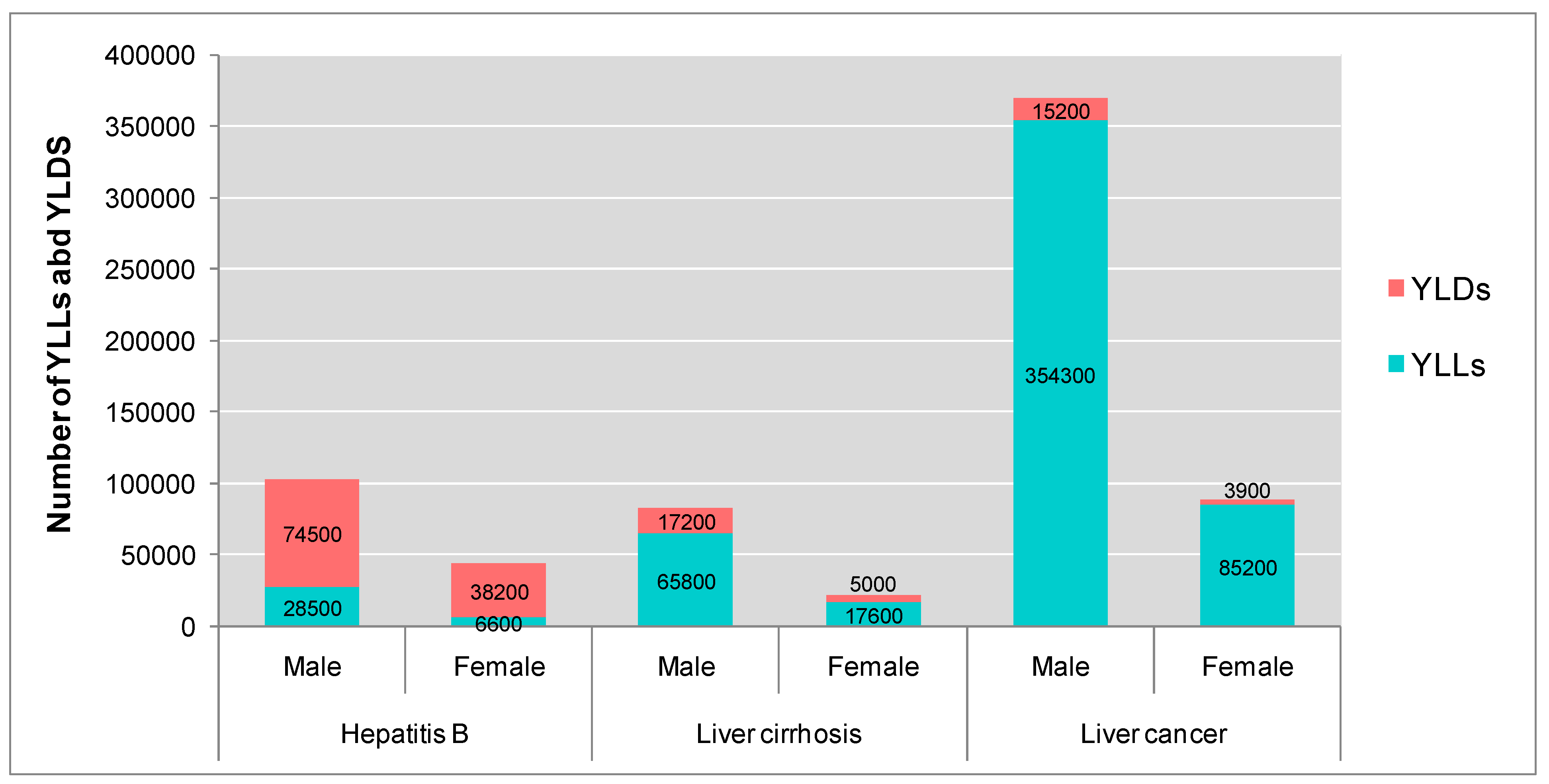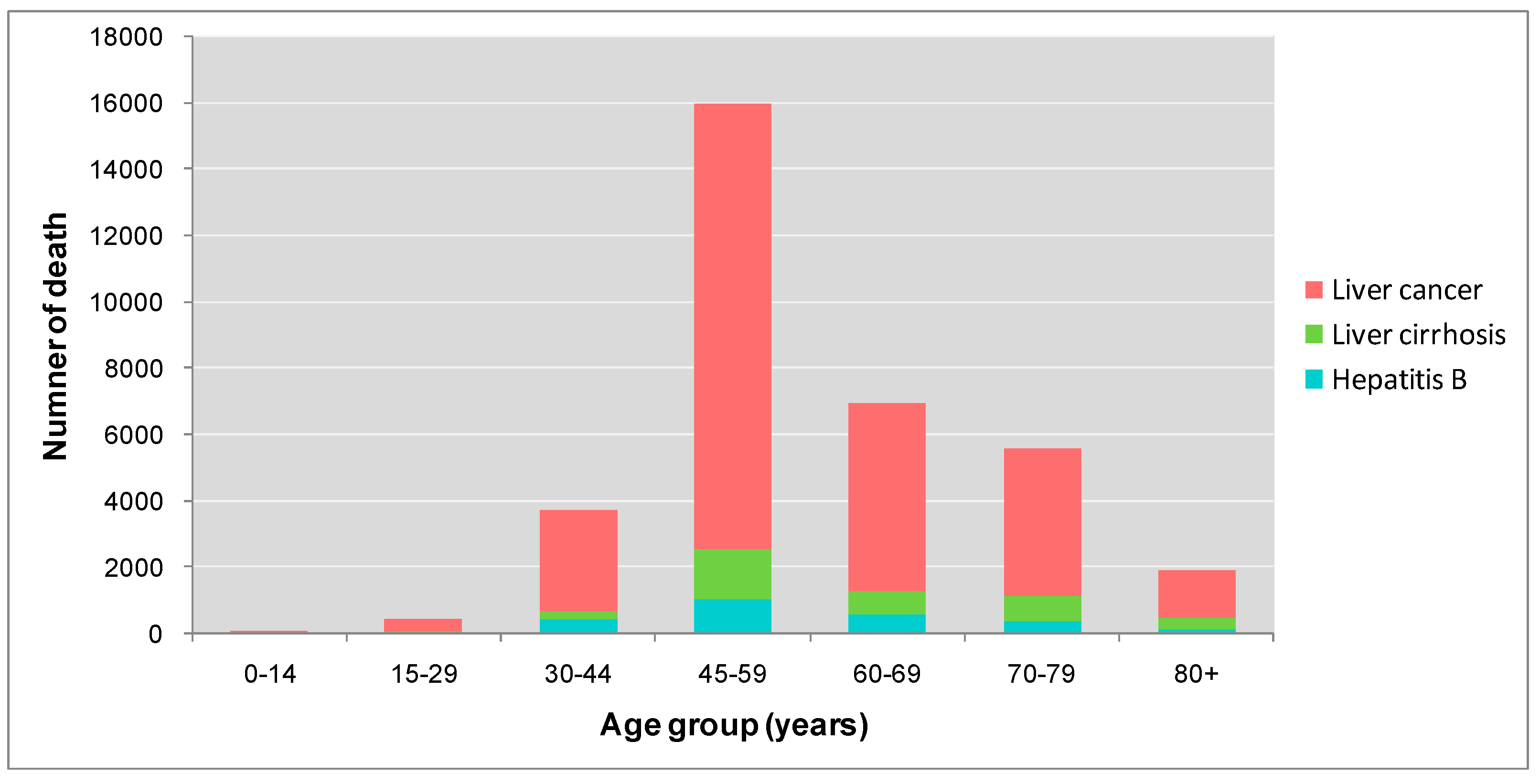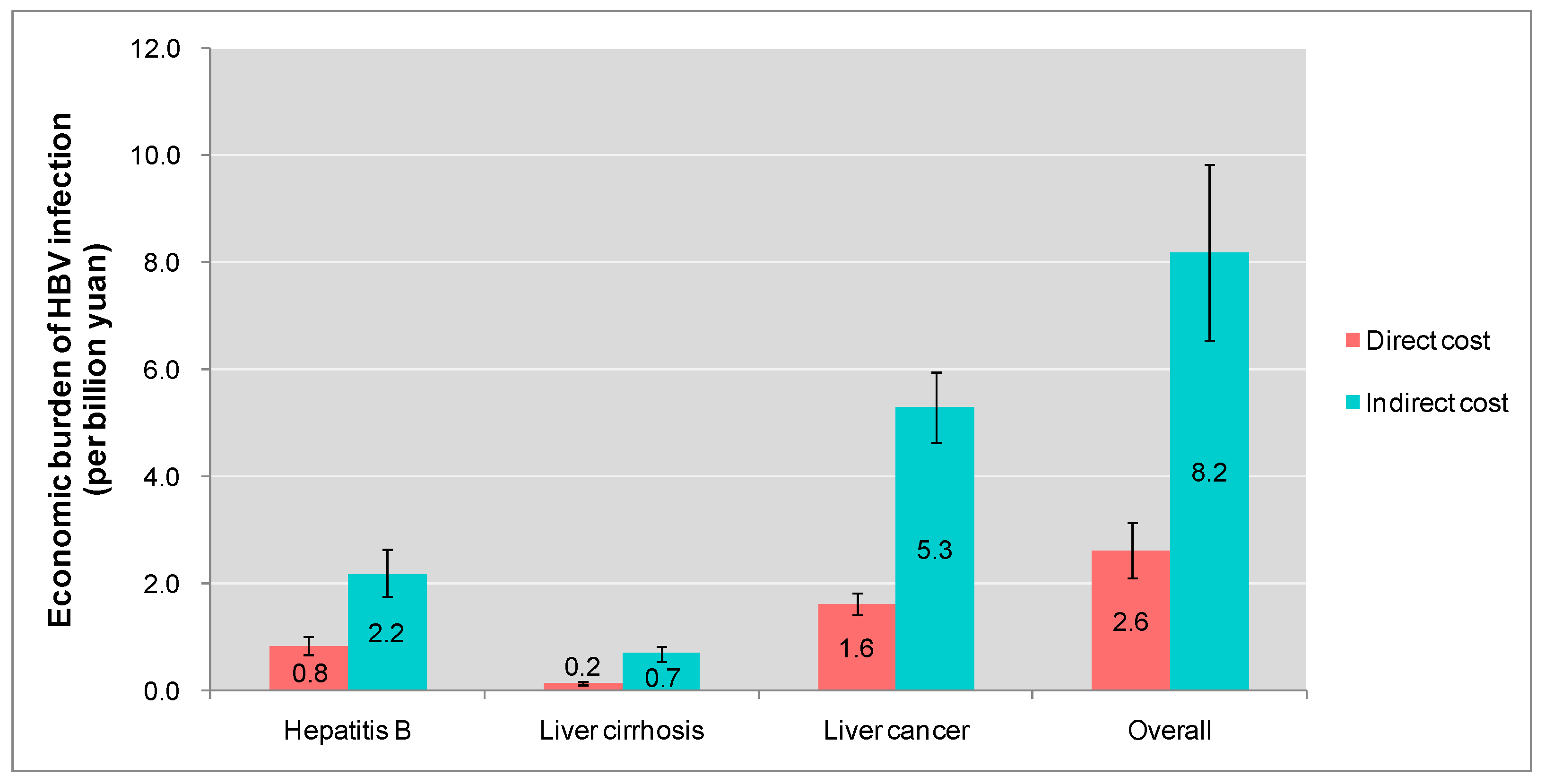Disease Burden from Hepatitis B Virus Infection in Guangdong Province, China
Abstract
:1. Instruction
2. Materials and Methods
2.1. Data Collection
2.2. Statistical Analysis
2.2.1. DALYs Calculation
2.2.2. DALYs for Hepatitis B
2.2.3. DALYs for Liver Cirrhosis
2.2.4. DALYs for Liver Cancer
2.3. Attributable Burden Estimation
2.4. Economic Burden Estimation
2.5. Uncertainty Analysis
3. Results
| Variables | Incidence (Per 100000) | Mortality (Per 100000) | Disability Weight | Duration (Years) | Attributable Fraction (95% CI) | Medical Expense Per Capita (RMB) |
|---|---|---|---|---|---|---|
| Hepatitis B | 39.4 (39.0–39.8) | 2.9 (2.8–3.0) | 0.21 | 14.1 | 1.0 | 20,450 |
| Male | 50.9 (50.2–51.6) | 4.3 (4.1–4.5) | 0.21 | 14.1 | 1.0 | 20,450 |
| Female | 27.0 (26.5–27.5) | 1.5 (1.4–1.6) | 0.21 | 14.1 | 1.0 | 20,450 |
| Liver cirrhosis | − | 8.0 (7.8–8.2) | − | − | 0.5 (0.4–0.6) | 42,467 |
| Male | − | 11.6 (11.3–11.9) | − | − | 0.5 (0.4–0.6) | 42,467 |
| Female | − | 4.4 (4.2–4.6) | − | − | 0.5 (0.4–0.6) | 42,467 |
| Liver cancer | − | 37.0 (36.6–37.4) | 0.44 | 1.0 | 0.8 (0.7–0.9) | 57,692 |
| Male | − | 56.1 (55.4–56.8) | 0.42 | 1.0 | 0.8 (0.7–0.9) | 57,692 |
| Female | − | 17.3 (16.9–17.7) | 0.45 | 1.0 | 0.8 (0.7–0.9) | 57,692 |

| Variables | Death (Thousands) | Death rate (Per 100,000) | DALYs (Thousands) | DALYs Rate (Per 100,000) |
|---|---|---|---|---|
| Overall | 33.6 | 36.5 | 583.2 | 634.3 |
| (29.3–37.8) | (31.9–41.1) | (495.2–671.1) | (538.7–730.0) | |
| Male | 25.6 | 55.0 | 452.8 | 972.5 |
| (22.4–28.8) | (48–61.9) | (385.4–520.2) | (827.6–1117.3) | |
| Female | 8.0 | 17.5 | 130.4 | 287.3 |
| (6.9–9.0) | (15.3–19.8) | (109.9–150.9) | (242.1–332.5) | |
| Hepatitis B | 2.7 | 2.9 | 147.8 | 160.8 |
| (2.6–2.8) | (2.8–3.0) | (118.3–177.4) | (128.6–193.0) | |
| Male | 2.0 | 4.3 | 103.0 | 221.2 |
| (1.9–2.1) | (4.1–4.5) | (82.4–123.6) | (176.9–265.4) | |
| Female | 0.7 | 1.5 | 44.8 | 98.8 |
| (0.6–0.7) | (1.4–1.6) | (35.9–53.8) | (79.1–118.6) | |
| Liver cirrhosis | 3.7 | 4.0 | 52.8 | 57.4 |
| (2.9–4.4) | (3.2–4.8) | (42.2–63.3) | (45.9–68.9) | |
| Male | 2.7 | 5.8 | 41.5 | 89.1 |
| (2.2–3.2) | (4.6–7.0) | (33.2–49.8) | (71.3–106.9) | |
| Female | 1.0 | 2.2 | 11.3 | 24.8 |
| (0.8–1.2) | (1.8–2.6) | (9.0–13.5) | (19.8–29.8) | |
| Liver cancer | 27.2 | 29.6 | 382.6 | 416.1 |
| (23.8–30.6) | (25.9–33.3) | (334.8–430.4) | (364.1–468.1) | |
| Male | 20.9 | 44.9 | 308.3 | 662.2 |
| (18.3–23.5) | (39.3–50.5) | (269.8–346.9) | (579.4–745.0) | |
| Female | 6.3 | 13.8 | 74.3 | 163.6 |
| (5.5–7.1) | (12.1–15.6) | (65.0–83.5) | (143.2–184.1) |



| Assumption in Best Estimate | Alternative Condition | Effect on Number of Deaths, DALYs, Cost |
|---|---|---|
| 1. Best estimate attributable fraction from meta analyses or original papers. | Upper 95% confidence interval | Death increased by 10.1% (3400 deaths) |
| Lower 95% confidence interval | Death decreased by 10.1% (3400 deaths) | |
| 2. The cause-of-death statistics from the mortality survey reflect actual situation. | Using the mortality of 7 per thousand for Guangdong | Death increased by 6.1% (2097 deaths) |
| 3. The life expectancy used can reflect actual situation in Guangdong. | New life table based on the 2010 GBD report was referenced | DALYs increased by 14.0% (95,648DALYs) |
| 4. The incidence of hepatitis B used reflect actual situation in Guangdong. | Incidence of hepatitis B based on the surveillance system of infectious diseases | DALYs increased by 14.9% (101,800 DALYs) |
| 5. The direct cost investigated from patients can represent provincial level. | Using the estimation from another survey in Guangdong | Direct cost decreased by 9% (RMB 0.2 billion) |
4. Discussion
5. Conclusions
Acknowledgements
Author Contributions
Conflicts of Interest
References
- Liaw, Y.F.; Chu, C.M. Hepatitis B virus infection. Lancet 2009, 373, 582–592. [Google Scholar] [CrossRef]
- Trepo, C.; Chan, H.L.; Lok, A. Hepatitis B virus infection. Lancet 2014, 384, 2053–2063. [Google Scholar] [CrossRef]
- Lavanchy, D. Hepatitis B virus epidemiology, disease burden, treatment, and current and emerging prevention and control measures. J. Viral Hepatitis 2004, 11, 97–107. [Google Scholar] [CrossRef]
- Lim, S.S.; Vos, T.; Flaxman, A.D.; Danaei, G.; Shibuya, K.; Adair-Rohani, H. A comparative risk assessment of burden of disease and injury attributable to 67 risk factors and risk factor clusters in 21 regions, 1990–2010: A systematic analysis for the global burden of disease study 2010. Lancet 2012, 380, 2224–2260. [Google Scholar] [CrossRef]
- Naghavi, M.; Wang, H.; Lozano, R.; Davis, A.; Liang, X.; Zhou, M.; Vollset, S.E.; Ozgoren, A.A.; Abdalla, S.; Abd-Allah, F.; et al. Global, regional, and national age-sex specific all-cause and cause-specific mortality for 240 causes of death, 1990–2013: A systematic analysis for the global burden of disease study 2013. Lancet 2015, 10, 117–171. [Google Scholar]
- Wang, F.S.; Fan, J.G.; Zhang, Z.; Gao, B.; Wang, H.Y. The global burden of liver disease: The major impact of China. Hepatology 2014, 60, 2099–2108. [Google Scholar] [CrossRef] [PubMed]
- Yang, G.; Wang, Y.; Zeng, Y.; Gao, G.F.; Liang, X.; Zhou, M.; Wan, X.; Yu, S.; Jiang, Y.; Naghavi, M. Rapid health transition in China, 1990–2010: Findings from the global burden of disease study 2010. Lancet 2013, 381, 1987–2015. [Google Scholar] [CrossRef]
- Liang, X.; Bi, S.; Yang, W.; Wang, L.; Cui, G.; Cui, F.; Zhang, Y.; Liu, J.; Gong, X.; Chen, Y.; et al. Epidemiological serosurvey of Hepatitis B in China—Declining HBV prevalence due to Hepatitis B vaccination. Vaccine 2009, 27, 6550–6557. [Google Scholar] [CrossRef] [PubMed]
- Xiao, J.; Zhang, J.; Wu, C.; Shao, X.; Peng, G.; Peng, Z.; Ma, W.; Zhang, Y.; Zheng, H. Impact of hepatitis B vaccination among children in Guangdong Province, China. Int. J. Infect. Dis. 2012, 16, 692–696. [Google Scholar] [CrossRef] [PubMed]
- Hu, M.; Chen, W. Assessment of total economic burden of chronic hepatitis B (CHB)-related diseases in Beijing and Guangzhou, China. Value Health 2009, 12, S89–S92. [Google Scholar] [CrossRef] [PubMed]
- Lu, J.; Xu, A.; Wang, J.; Zhang, L.; Song, L.; Li, R.; Zhang, S.; Zhuang, G.; Lu, M. Direct economic burden of hepatitis B virus related diseases: Evidence from Shandong, China. BMC Health Ser. Res. 2013. [Google Scholar] [CrossRef] [PubMed]
- Kim, S.Y.; Salomon, J.A.; Goldie, S.J. Economic evaluation of hepatitis B vaccination in low-income countries: Using cost-effectiveness affordability curves. Bull. WHO 2007, 85, 833–842. [Google Scholar] [PubMed]
- Ong, S.C.; Lim, S.G.; Li, S.C. How big is the financial burden of hepatitis b to society? A cost-of-illness study of Hepatitis B infection in singapore. J. Viral Hepatitis. 2009, 16, 53–63. [Google Scholar] [CrossRef] [PubMed]
- Goldstein, S.T.; Zhou, F.; Hadler, S.C.; Bell, B.P.; Mast, E.E.; Margolis, H.S. A mathematical model to estimate global Hepatitis B disease burden and vaccination impact. Int. J. Epidemiol. 2005, 34, 1329–1339. [Google Scholar] [CrossRef] [PubMed]
- Yang, B.M.; Kim, D.J.; Byun, K.S.; Kim, H.S.; Park, J.W.; Shin, S. The societal burden of HBV-related disease: South Korea. Dig. Dis. Sci. 2010, 55, 784–793. [Google Scholar] [CrossRef] [PubMed]
- Qi, W.T.; Sun, J.D.; Xu, A.Q.; Zhang, L.; Li, R.P.; Ma, J.X.; Guo, X.L.; Fan, Q.Y.; Yang, H. Estimation on disease burden related to hepatitis B virus infection in Shandong Province of China. Chin. J. Epidemiol. 2009, 30, 679–683. [Google Scholar]
- Jia, Y.; Li, L.; Cui, F.; Zhang, D.; Zhang, G.; Wang, F.; Gong, X.; Zheng, H.; Wu, Z.; Miao, N.; et al. Cost-effectiveness analysis of a hepatitis B vaccination catch-up program among children in Shandong Province, China. Hum. Vaccin. Immunother. 2014, 10, 2983–2991. [Google Scholar] [CrossRef] [PubMed]
- Cui, F.Q.; Wang, F.Z.; Zheng, H.; Chen, Y.S.; Gong, X.H.; Wang, H.Q.; Liang, X.F. Analysis on reported cases of hepatitis b in china in 2005–2007. Chin. J. Vaccin. Immunization 2008, 413–417. [Google Scholar]
- Xu, Y.J.; Xu, X.J.; Ma, W.J.; Cai, Q.M.; Song, X.L.; Xu, H.F.; Meng, R.L. Analysis on the characteristics of alimentary canal cancer deaths in guangdong province. Chin. J. Epidemiol. 2012, 33, 121–122. [Google Scholar]
- Ma, Q.S.; Zou, Y.H.; Zhang, S.X.; Liang, S.; Xiao, H.W.; Xie, X.; Mei, S.J.; Jia, W.D.; Zhang, Y.F.; Cui, F.Q.; et al. Estimation on the intangible cost and influencing factors for patients with hepatitis B-related diseases. Chin. J. Epidemiol. 2011, 32, 764–767. [Google Scholar]
- Murray, C.J.; Vos, T.; Lozano, R.; Naghavi, M.; Flaxman, A.D.; Michaud, C. Disability-adjusted life years (dalys) for 291 diseases and injuries in 21 regions, 1990–2010: A systematic analysis for the global burden of disease study 2010. Lancet 2012, 380, 2197–2223. [Google Scholar] [CrossRef]
- WHO. Who Methods and Data Sources for Global Burden of Disease Estimates 2000–2011. Available online: http://www.who.int/healthinfo/statistics/GlobalDALYmethods_2000_2011.pdf (accessed on 12/03/2015).
- WHO. National Burden of Disease Studies: A Practical Guide. Available online: http://www.who.int/healthinfo/nationalburdenofdiseasemanual.pdf. (accessed on 11/01/2015).
- Pokorski, R.J.; Ohlmer, U. Long-term morbidity and mortality in chinese insurance applicants infected with the hepatitis B virus. J. Insur. Med. 2001, 33, 143–164. [Google Scholar] [PubMed]
- Chen, J.G.; Lu, J.H.; Zhu, Y.R.; Zhu, J.; Zhang, Y.H. A thirty-one year prospective follow-up program on the HBSAG carrier state and primary liver cancer in Qidong, China. Chin. J. Epidemiol. 2010, 31, 721–726. [Google Scholar]
- Tan, S.K.; Qiu, X.Q.; Yu, H.P.; Zeng, X.Y.; Xiao, Z.M.; Hu, L. Etiologic fraction and interaction of risk factors for primary hepatic carcinoma in Guangxi, China. Chin. J. Prevent. Med. 2008, 42, 169–172. [Google Scholar]
- Inocencio, T.J.; Carroll, N.V.; Read, E.J.; Holdford, D.A. The economic burden of opioid-related poisoning in the United States. Pain Medicine 2013, 14, 1534–1547. [Google Scholar] [CrossRef] [PubMed]
- Liang, X.; Bi, S.; Yang, W.; Wang, L.; Cui, G.; Cui, F.; Zhang, Y.; Liu, J.; Gong, X.; Chen, Y.; et al. Evaluation of the impact of hepatitis B vaccination among children born during 1992–2005 in China. J. Infect. Dis. 2009, 200, 39–47. [Google Scholar] [CrossRef] [PubMed]
© 2015 by the authors; licensee MDPI, Basel, Switzerland. This article is an open access article distributed under the terms and conditions of the Creative Commons Attribution license (http://creativecommons.org/licenses/by/4.0/).
Share and Cite
Xiao, J.; Lin, H.; Liu, T.; Zeng, W.; Li, X.; Shao, X.; Tan, Q.; Xu, Y.; Xu, X.; Zheng, H.; et al. Disease Burden from Hepatitis B Virus Infection in Guangdong Province, China. Int. J. Environ. Res. Public Health 2015, 12, 14055-14067. https://doi.org/10.3390/ijerph121114055
Xiao J, Lin H, Liu T, Zeng W, Li X, Shao X, Tan Q, Xu Y, Xu X, Zheng H, et al. Disease Burden from Hepatitis B Virus Infection in Guangdong Province, China. International Journal of Environmental Research and Public Health. 2015; 12(11):14055-14067. https://doi.org/10.3390/ijerph121114055
Chicago/Turabian StyleXiao, Jianpeng, Hualiang Lin, Tao Liu, Weilin Zeng, Xing Li, Xiaoping Shao, Qiu Tan, Yanjun Xu, Xiaojun Xu, Huizhen Zheng, and et al. 2015. "Disease Burden from Hepatitis B Virus Infection in Guangdong Province, China" International Journal of Environmental Research and Public Health 12, no. 11: 14055-14067. https://doi.org/10.3390/ijerph121114055
APA StyleXiao, J., Lin, H., Liu, T., Zeng, W., Li, X., Shao, X., Tan, Q., Xu, Y., Xu, X., Zheng, H., & Ma, W. (2015). Disease Burden from Hepatitis B Virus Infection in Guangdong Province, China. International Journal of Environmental Research and Public Health, 12(11), 14055-14067. https://doi.org/10.3390/ijerph121114055







